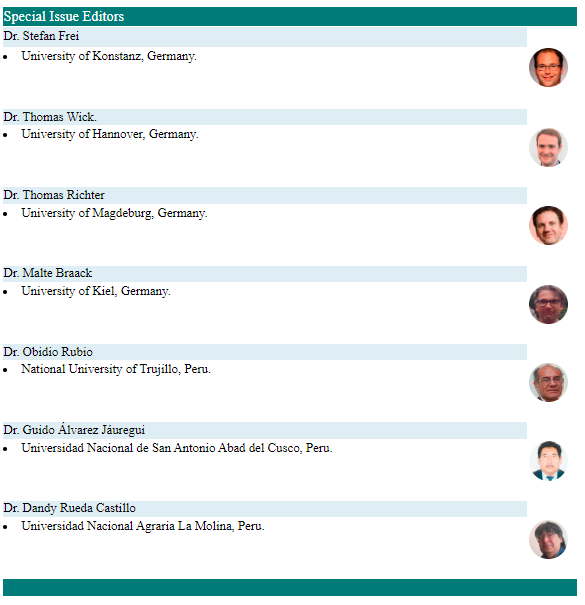Traveling waves in a delayed reaction-diffusion SVIR epidemic model with generalized incidence function and imperfect vaccination
DOI:
https://doi.org/10.17268/sel.mat.2025.01.04Palabras clave:
Imperfect vaccination, minimal wave speed, delay, basic reproduction numberResumen
This paper is concerned with traveling wave solutions for a delayed reaction-diffusion SVIR epidemic model that includes both general incidence function and imperfect vaccination. In the model, the spread of infection in space is explicitly taken into account by using a heterogeneous environment; it takes into consideration the delay in immune response and inefficiency in vaccinations. The analysis carried out below shows that the basic reproduction number Ro will be a critical value for determining the existence of traveling waves. More precisely, when Ro > 1 there exists a minimal wave speed ρ* > 0 such that the system admits nontrivial traveling wave solutions for ρ ≥ ρ* whereas no such solutions exist for ρ < ρ*. On the other hand, if Ro ≤ 1, there are no traveling wave solutions. The introduction of delays and imperfect vaccination adds richness and complexity to the dynamics, such as possible wave speed adjustments and pattern formations, which are hallmarks of complex systems. This work develops a theoretical framework that shall guide the understanding of how delays, spatial spread, and control measures interact in epidemic systems and offers insights applicable to real-world infectious disease dynamics. Numerical simulations for some typical nonlinear incidence functions are given in the last to illustrate the existence of traveling waves.
Citas
Dong F, Li W, Wang J. Propagation dynamics in a three-species competition model with nonlocal anisotropic dispersal. Nonlinear Analysis: Real World Applications. 2019;48:232-66.
Tomás C, Fatini M, Pettersson M. A stochastic SIRI epidemic model with relapse and media coverage. Discrete and Continuous Dynamical Systems. 2018;23(8):3483-501.
Cai Y, Wang W. Fish-hook bifurcation branch in a spatial heterogeneous epidemic model with cross-diffusion. Nonlinear Analysis: Real World Applications. 2016;30:99-125.
Thieme H, Zhao X. Asymptotic speeds of spread and traveling waves for integral equations and delayed reactiondiffusion models. Journal of Differential Equations. 2003;195(2):430-70.
Crooks E, Dancer E, Hilhorst D, Mimura M, Ninomiya H. Spatial segregation limit of a competition-diffusion system with Dirichlet boundary conditions. Nonlinear Analysis: Real World Applications. 2004;5(4):645-65.
Murray JD. Mathematical Biology II: Spatial Models and Biomedical Applications. Springer; 2002.
Shigesada N, Kawasaki K. Biological Invasions: Theory and Practice. Oxford University Press; 1997.
Djilali S, Bentout S. Global dynamics of SVIR epidemic model with distributed delay and imperfect vaccine. Results in Physics. 2021. Available from: https://doi.org/10.1016/j.rinp.2021.104569.
Liu X, Takeuchi Y, Iwami S. SVIR epidemic models with vaccination strategies. Journal of Theoretical Biology. 2008;253:1-11.
Xu J, Zhou Y. Global stability of a multi-group model with vaccination age, distributed delay and random perturbation. Mathematical Biosciences and Engineering. 2015;12:1083-106.
Duan X, Yuan S, Li X. Global stability of an SVIR model with age of vaccination. Applied Mathematics and Computation. 2014;226:528-40.
Wang J, Zhang R, Kuniya T. The dynamics of an SVIR epidemiological model with infection age. IMA Journal of Applied Mathematics. 2016;81:321-43.
Diekmann O, Heesterbeek JAP, Britton T. Mathematical Tools for Understanding Infectious Disease Dynamics. Princeton University Press; 2013.
Hethcote HW. The mathematics of infectious diseases. SIAM Review. 2000;42:599-653. Available from: https://doi.org/10.1137/S0036144500371907.
Guenad B, Darazirar R, Djilali S, Alraddadi I. Traveling waves in a delayed reaction–diffusion SIR epidemic model with a generalized incidence function. Nonlinear Dynamics. 2024.
Ran Z, Liu S. Traveling waves for SVIR epidemic model with nonlocal dispersal. Mathematical Biosciences and Engineering. 2019;16(3):1654-82.
Peng R, Liu S. Global stability of the steady states of an SIS epidemic reaction-diffusion model. Nonlinear Analysis: Theory, Methods and Applications. 2009;71:239-47.
Lou Y, Zhao XQ. A reaction-diffusion malaria model with incubation period in the vector population. Journal of Mathematical Biology. 2011;62:543-68.
Ducrot A, Magal P. Travelling wave solutions for an infection-age structured epidemic model with external supplies. Nonlinearity. 2011;24:2891-911.
Djilali S, Darazirar R, Alraddadi I. Traveling wave solution for a delayed reaction-diffusion two-group SIR epidemic model with a generalized nonlinear incidence function. Journal of Applied Mathematics and Computing. 2025. Available from: https://doi.org/10.1007/s12190-025-02474-4.
Darazirar R, Yaseen RM, Mohsen AA, et al. Minimal wave speed and traveling wave in nonlocal dispersion SIS epidemic model with delay. Boundary Value Problems. 2025. Available from: https://doi.org/10.1186/s13661-025-02055-1.
Weinberger HF. Long-time behavior of a class of biological models. SIAM Journal on Mathematical Analysis. 1982;13:353-96.
Hosono Y, Ilyas B. Traveling waves for a simple diffusive epidemic model. Mathematical Models and Methods in Applied Sciences. 1995;5:935-66. Available from: https://doi.org/10.1142/S0218202595000431.
Wang J, Modnak C, Eisenberg JN. Backward bifurcations in disease models: Applications to waterborne infections. Mathematical Biosciences. 2012;240:227-34. Available from: https://doi.org/10.1016/j.mbs.2012.07.004.
Liu Y, Wu J. Traveling waves and spreading speeds for an epidemic model with spatial diffusion and delay. Journal of Mathematical Biology. 2020;80:235-59. Available from: https://doi.org/10.1007/s00285-019-01385-5.
Huang G, Takeuchi Y, Ma W, Wei D. Global stability for delay SIR and SEIR epidemic models with nonlinear
incidence rate. Bulletin of Mathematical Biology. 2010;72:1192-207. Available from: https://doi.org/10.1007/s11538-010-9489-6.
Korobeinikov A, Maini PK. Non-linear incidence and stability of infectious disease models. Mathematical Medicine and Biology: A Journal of the IMA. 2005;22(2):113-28. Available from: https://doi.org/10.1093/imammb/dqi005.
Hartman P. Ordinary Differential Equations. Society for Industrial and Applied Mathematics; 2002.
Fu SC. Traveling waves for a diffusive SIR model with delay. Journal of Mathematical Analysis and Applications. 2016;435:20-37. Available from: https://doi.org/10.1016/j.jmaa.2015.10.018.
Descargas
Publicado
Cómo citar
Número
Sección
Licencia

Esta obra está bajo una licencia internacional Creative Commons Atribución 4.0.
Los autores/as que publiquen en esta revista aceptan las siguientes condiciones:
- Los autores/as conservan los derechos de autor y ceden a la revista el derecho de la primera publicación, con el trabajo registrado con la licencia de atribución de Creative CommonsAtribución 4.0 Internacional (CC BY 4.0) , que permite a terceros utilizar lo publicado siempre que mencionen la autoría del trabajo y a la primera publicación en esta revista.
- Los autores/as pueden realizar otros acuerdos contractuales independientes y adicionales para la distribución no exclusiva de la versión del artículo publicado en esta revista (p. ej., incluirlo en un repositorio institucional o publicarlo en un libro) siempre que indiquen claramente que el trabajo se publicó por primera vez en esta revista.
- Se permite y recomienda a los autores/as a publicar su trabajo en Internet (por ejemplo en páginas institucionales o personales) antes y durante el proceso de revisión y publicación, ya que puede conducir a intercambios productivos y a una mayor y más rápida difusión del trabajo publicado(Consultar: efecto del acceso abierto).













